In which I ramble in relation to the following: 5 Books (Dancing On Our Turtle’s Back; The Songs of Trees; Bookshops; A Separation; and Selfish); 5 Movies (Phantom Thread; Sambizanga; On Body and Soul; Graduation; and We Need to Talk About Kevin); 1 Documentary (Tokyo Idols).
BOOKS
1. Dancing on Our Turtle’s Back: Stories of Nishnaabeg Re-Creation, Resurgence and a New Emergence by Leanne Betasamosake Simpson.

I increasingly admire writers who are able to think carefully, critically, and constructively, but who do so while fostering an environment of shared intimacy and vulnerability with the reader. These are writers who speak not only what is on their minds but who speak from their hearts and, thus, speak both to the minds and hearts of the readers. This is not always easy to do and a lot of academia (and our culture more generally) discourages it). But Leanne Betasamosake Simpson, Michi Saagiig scholar, storyteller, mother, learner, and basically-modern-day-antithesis-to-Indiana-Jones, does this brilliantly. This is some of the most beautiful, moving, practical, and transformative writing I have ever read. The focus, of course, is on Indigenous identity and resurgence, and it is rooted in Michi Saagiig stories and language, as words and characters and plots are developed, chewed on, played with, thought about, unpacked, and applied, but I think the book is exceptionally relevant for anyone living within the context of the ongoing and ever always violent Canadian occupation of these territories. The paucity of this review shouldn’t fool you – it’s hard for me to discuss the content in a brief review because the content is so rich and I wouldn’t even know where to start and how to pick what to pull out and what to leave unmentioned. It’s a short book anyway so you’re much better off just walking away from these reviews and reading it now. I almost never say this about books but reading this one has the potential to make you a better person. Seriously. Read it.
2. The Songs of Trees: Stories from Nature’s Great Connectors by David George Haskell.

This is a book full of wonder and excitement where one quite literally listens in on trees and leaves and pine needles and the different voices of the wind or rain as one moves from rainforest to island to mountain to city. It is an adventure but also a homecoming as Haskell bears witness to a process of unselfing wherein we (re)discover our interconnectedness with all of life as we also (re)discover that all is life. Because of Haskellm I will be taking a stethoscope with me on hikes (and, as we will see next month, it is because of Robin Wall Kimmerer’s book on mosses that I will be bringing a magnifying glass with me). I’ve also started listening to the wind again (it is one of the few features of the soundscape that the noise pollution of a city doesn’t block out very well). As Haskell demonstrates, he wonder isn’t far away — in distant lands, on a tropical beach or a snowy mountaintop — it is all around us. We simply have to awaken to it. We have to learn, anew, how to see, how to hear, how to smell and taste and feel. We knew these things, once upon a time – like Kayden when she first felt the rain, I see it all the time in my children. I saw the hush of the wonder of the sacred settle upon them when we came face to face with a deer while hiking in a bog last week, and I too felt the hush of the wonder of the sacred with them. I voiced the same “wow!” the weekend before when, suddenly breaking through the tree line at Lion’s Head, halfway up the Bruce Peninsula, Jess and I emerged on the top of the escarpment and looked down on the ice striated by wind above and currents below that was creeping out on Georgian Bay. So we can recover these things as we move beyond the walls of sound and light and smells we have built around ourselves in cities and earbuds and roadways and screens. And as we recover ourselves as bodies that see and hear and smell and taste and touch and feel, we simultaneously begin to move beyond ourselves into the flows and patterns and textures and life of all that we are now experiencing. Haskell presents us with a beautiful gift by guiding us into that process. This is highly recommended reading.
3. Bookshops: A Reader’s History by Jorge Carrión.
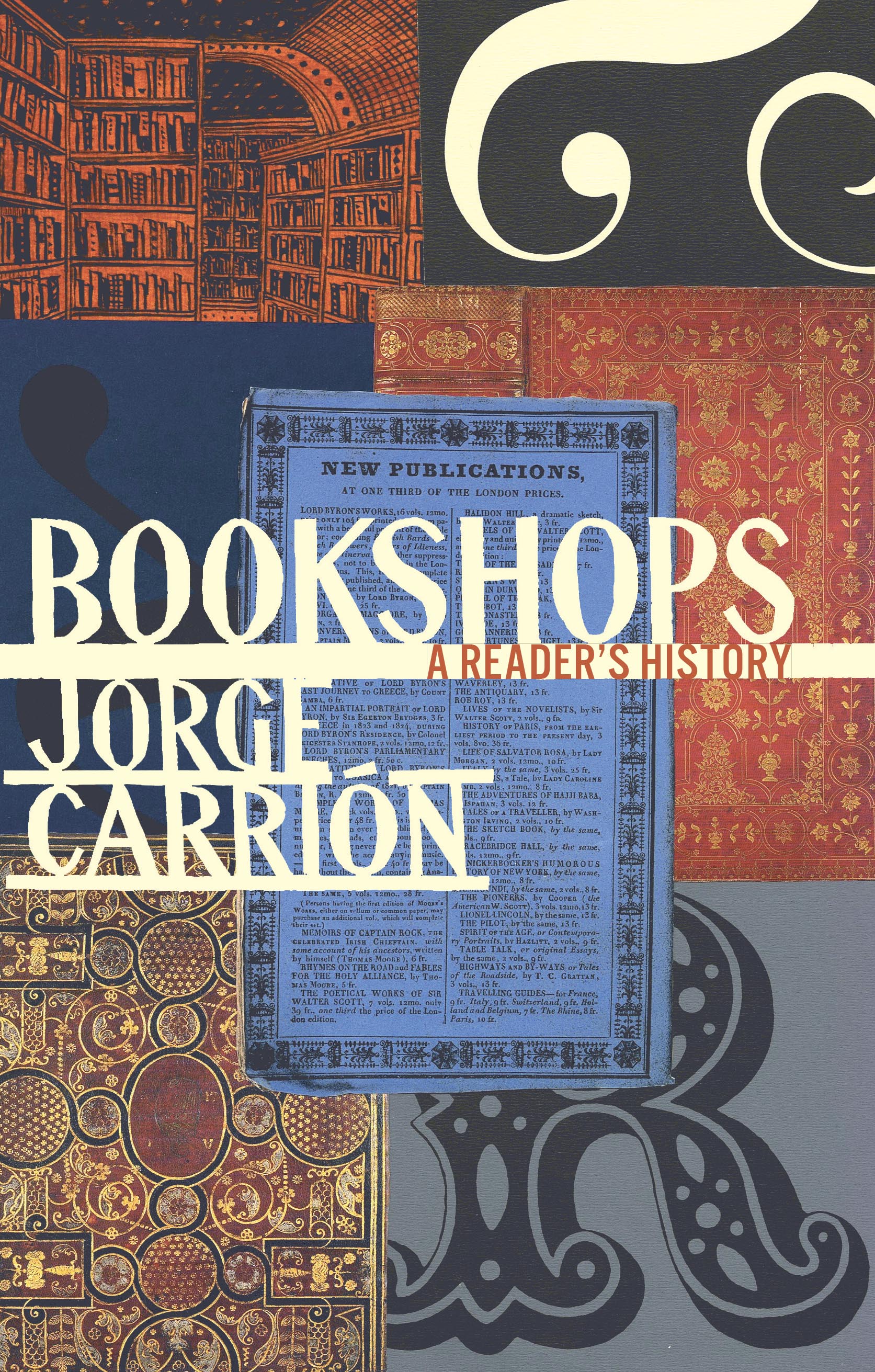
Every December, I make sure to read Brad Johnson’s year end list of books. It is, in my opinion, the best and most reliable annual list of high quality (and also enjoyable) literature and I often discover authors through Brad. I read Seiobo There Below because of what Brad said about it and I’ve been devouring everything by Maggie Nelson because Brad said something about The Argonauts. In fact, my love affair with my current favourite author, W. G. Sebald, began when Brad mentioned Austerlitz some years ago. No other reader of fiction has so heavily influenced my own development as a reader. Consequently, when he mentioned Jorge Carrión’s book about bookshops last December, and when he compared it to Sebald’s work, I hurried to pick it up.
I enjoyed the book quite a bit although I thought it failed to wholly attain the tone of gentle melancholy that dominates Sebald’s work. It also seemed to be lacking the gradual build to the kind of unexpected revelation (or apocalypse or rupture) that is one of the things I love about Sebald (I think Sebald’s sentence structure has a lot to do with that and Carrión structures sentences in a more conservative manner). Still, as a lover of books and bookshops (I have, alas, only been to three of the bookshops Carrión mentions in this book – City Lights in San Francisco, Powell’s in Portland, and Shakespeare and Company in Paris), I still found myself looking forward to picking the book back up and reading a little more every day. I wanted to savour the experience and think about all the lines Carrión draws between readers and writers and commerce and culture and aesthetics and, well, it’s all kind of Derridean only here we might play at something more Borgesian and replace one word from his famous phrase to make it say, il n’y a pas de hors-librarie.
(As something of a postscript, it is also worth noting that Carrión, in a manner akin to Sebald and Nelson and Brad, introduced me to several other authors who were unknown to me and whom I am keen to explore further.)
4. A Separation by Katie Kitamura.
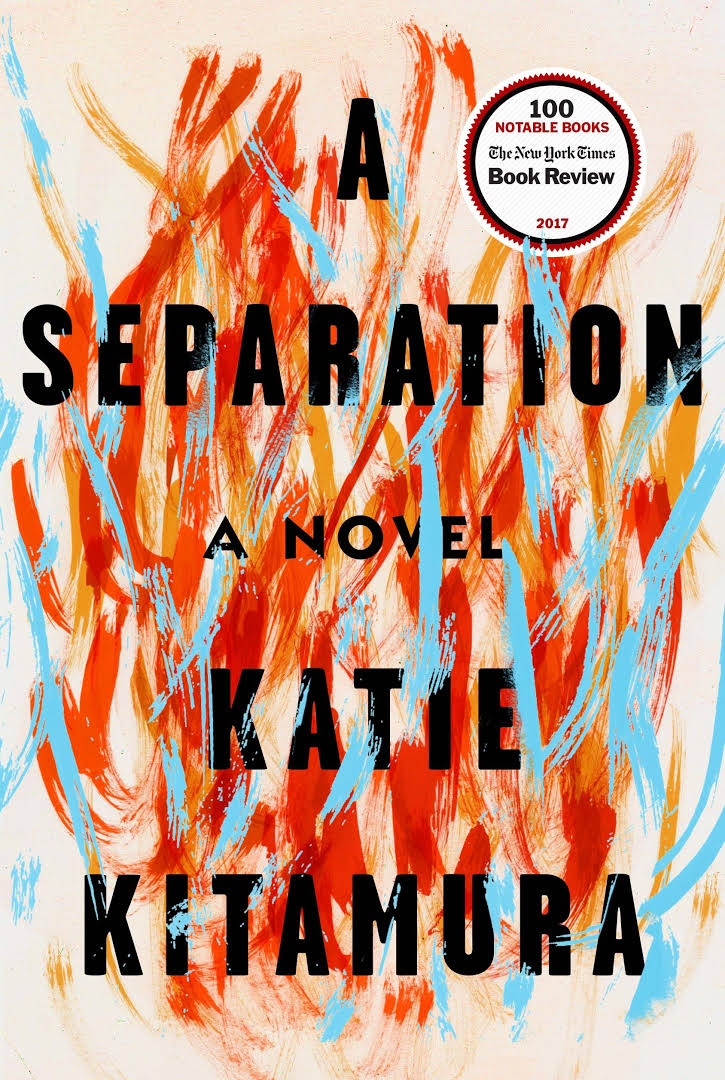
This is another of Brad’s picks and, although he compares Katie Kitamura to Elena Ferrante, I’m less convinced. That doesn’t mean this is a crummy book – it’s quite good – but it is, perhaps, difficult to compare a book of this length to something like the Neapolitan series (although I think Margarita Karapanou’s very short novels and Maggie Nelson’s kinda short novels can stand next to Ferrante’s much longer series so maybe size isn’t the issue…). I suppose A Separation could stand more easily beside something like Troubling Love (and alienation definitely features in both) but, in my opinion, Troubling Love was a bit of a problematical text.
There is an interesting flow to A Separation. The protagonist is consistently derailed. Everything is going a certain way. Until it’s not. And while the protagonist (she remains unnamed) makes plans, and reflects, and analyzes, and translates, it is others (those with names) who act, and who compel her to go now one way, now another. Originally I wondered about this flow, as though each event that compels the plot forward may have surprised the author as much as the characters (the way it sometimes feels like writers add twists to stories because they like what they have so far but then didn’t know where to take everyone, so they twist the plot to keep it going [cf. J. J. Abrams, if he counts as a writer]), but looking back at the story, I think it was much more carefully constructed than that. Still, it has me thinking how ruptures qua ruptures are structured into texts and how, within the boundaries of a story that is being told by a storyteller, those things are made to fit or not fit with what comes before and after and how things are tied together or not and how this relates to fiction as fiction versus life as life (although life, too, is fiction but it is not always bound in the same way as a book).
5. Selfish by Kim Kardashian

In The Many Lives of Marilyn Monroe, Sarah Churchwell argues that, although various biographers and intimates claim to offer us the real Marilyn Monroe (often claiming to reveal the genuine person of Norma Jeane Baker Mortenson last-name-of-father-actually-unknown who is hidden behind the artificial persona of Marilyn – a move most prominently featured in Elton John’s song “Candle in the Wind,” which both posits the mystery of Marilyn while claiming intimacy by addressing her as Norma Jean… while also sensationalizing her nude body), the only proper conclusion to draw is that all of these offerings are too heavily over-coded with the desires of those writing them. The true or real Marilyn Monroe is inaccessible and every variation thereof is simply another manifestation of the Monroe mythos. Thus, this or that “real” Marilyn ever only ends up being a reflection constructed by the hopes or desires of the author (and this is as true of biographies written by her friend Truman Capote, as it is of the self-referential screenplay for The Misfits written by Arthur Miller as their marriage collapsed, as it is of the memories the photographer Andre des Diennes recorded about his muse, as it is of conclusions drawn by archivists who have amassed countless data sets from interviews, recordings, photographs, notebooks, and so on).
I was thinking about Monroe and her legacy and Churchwell’s comments when reading looking through these 445 pages featuring the many selfies of Kim Kardashian (although not all of these pictures are selfies – some are also pictures others took of her taking selfies – and there are some words, too, mostly about who did her hair and makeup or designed her outfit but also naming friends and some of the really fantastic or super great or fun or awesome places or events she was attending when the pictures were taken). I found it rather disconcerting to juxtapose these things. I found it disconcerting, in part, because it seems to suggest that our culture and technology may have developed in a way that makes something like Monroe entirely impossible now. And, while there is much that is problematical about how Monroe and her legacy have been endlessly appropriated and exploited, it seems to me that we may not have made any progress since then. In fact, the opposite might be the case. Thus, despite some points of comparison that one could make between Kardashian and Monroe, writing an academic text on the many lives of Kim Kardashian seems unthinkable. Because, while the real Marilyn may be inaccessible, nobody questions that Marilyn was real – but Kim, well, it seems to me that people would be more inclined to wonder if she was ever real at all. I mean, sure, there are countless photos and instagram likes and retweets and, of course, the sex tape that launched her rise to fame (which, I just learned, has grossed over $100,000,000) and endless reality series showing her dining and shopping and tanning and being with this or that family member or friend or pet, but is that a life? Is that real? I mean, really, part of Kim’s whole brand is being fake – we all know reality TV is scripted, and the body that she photographs endlessly has also been endlessly altered – breast implants, butt implants, injections into her lips, rhinoplasty for her nose, her cheeks have been filled, her hairline has been lifted, her wrinkles have been botoxed – so one is not inclined to speak about the “real” life, let alone “the many lives of” Kim Kardashian.
But of course Kim is real – she is as real as Marilyn, as real as you, as real as me, as real as anything. Yet looking through Selfish versus, say, The Last Sitting (a Marilyn Monroe photo collection) is an entirely different experience. This is not because Monroe is fundamentally different or other than Kardashian but because they have been coded with opposite themes. Hence, when I view The Last Sitting, I don’t just see the pictures, I also see tragedy and romance and melancholy and a fraught relationship with stardom and all the storylines that connect Monroe to these motifs (the title, of course, helps this along and helps to sell the book). All of this is a part of the core myth of Marilyn, a myth that is about the pursuit of the Real that lies hidden (but not entirely hidden!) behind the mask of the artificial or assumed. The myth of Kim is precisely the opposite of this. Her myth is the myth of the reality of the fake that is hidden (but not entirely hidden!) with claims to being real.
Of course, we need both myths to operate in our world – as Alone taught us years ago, we need to be able to point at things that are fake so that we can then point at other things and claim they are real (even though, as Alone goes on to say, what we take to be real is just as fake as everything else). Hence, Selfish is unsettling because, unlike The Last Sitting, if you sit with it for long enough, it makes you start feeling nervous that if Kim is not fake, if Kim is real, if Kim is like you and me and everyone else – and surely she is – then maybe nothing at all is real. Maybe reality itself is fake – a picture, not of a person but of a reflection in a mirror of a person who isn’t there.
Consequently, when I think of the shift from Monroe to Kardashian, I do not think we are falling away from the real to the fake (or surreal or artificial or whatever). Rather, I think it illustrates Baudrillard’s point that we have moved from simulations to simulacra. When I look at glossy images of Kim’s glossy eyes or glossy implants, I see the same shining thing that I see when I look in the mirror – a copy without an original.
MOVIES
1. Phantom Thread (2017) directed by P.T. Anderson.

P. T. Anderson is increasingly a mystery to me. His last three films – The Master, Inherent Vice, and Phantom Thread – have left me feeling as though I were in an alien world (in retrospect, I probably blamed Pynchon’s influence too much for that in relation to Inherent Vice) and I find myself asking, why this story, why these characters, why these foci, why this presentation, in ways that I usually don’t ask with other directors because, well, Hard Eight, Boogie Nights, Magnolia, and Punch Drunk Love (although, I think Punch Drunk Love is something of a transitional film between the earlier and later works). I’m increasingly unsure that I “get” P. T. Anderson but when I read the reviews and the critics, I don’t feel like they are picking up on things I’m missing (apart from one really fun review in the Guardian that pulled out a number of parallels to fairy tales and highlighted the gothic love story elements contained in Phantom Thread – and P. T. Anderson did say he wanted to make something of gothic tale so props to that reviewer). And yet, apart from those who are more affronted by the obvious toxic masculinity of Reynolds Woodcock (Daniel Day-Lewis), most are praising it as a work of genius. But if you read the reviews again (and I have), you might find yourself hard pressed to see the evidence of this. That P. T. Anderson is a genius and that he has produced works of genius in the past is, I think, well established, but that doesn’t mean Phantom Thread is a comparable work (although I absolutely agree that the actors do a phenomenal job – everyone talks about Day-Lewis doing what only Day-Lewis does and then also talks about how Vicky Krieps manages to equal his performance and even, at times, exceed it, and I think all this is true and I also think Lesley Manville’s performance as Reynold’s sister-and-everything-else is very well done and, when the film first concluded, I spent more time rethinking her character than I did thinking about the protagonists). I wonder if Phantom Thread falls under the same criticism I mention in my review of Body and Soul (see below), and if the parts taken individually, are actually of greater value than the whole. I also wonder, based on the paucity of evidence and the exorbitant praise in the reviews, if we have something like the Emperor’s new clothes going on here – everyone knows Anderson is a genius (and that certainly also remains true at a technical level in this film) so, if I can’t explain how this film is genius that probably means I’m too stupid to get it, so I better just praise it as genius and then everyone will know that I’m smart (or whatever). But I’m not sure about this theory. It could be that I really don’t “get” the film. And maybe it is just another relationship movie (Phantom Thread is, in part, Anderson’s response to Chris Rock’s query as to when he was going to make a relationship movie), only a semi-gothic one, with impeccable staging and acting, and one that weaves a complex negotiation of power and violence and love and control between the two leads, and that’s all it is. I’m not sure because, in part, I felt a strange sense of remove in watching it – like I wasn’t seeing what I was intended to see – like I was missing the phantom thread that weaves it all together and makes it brilliant.
2. Sambizanga (1972) directed by Sarah Maldoror.

African cinema remains a large gap in my viewing habits and so one of my goals this year is to work towards addressing that. To that end, I sat down and watched Sambizanga, a story that unfolds on the eve of the Angolan revolution against Portuguese colonization (on that score, it pairs well with Göran Olsson’s 2014 documentary, Concerning Violence). By a strange or fortuitous coincidence, I happened to watch Sambizanga on February 4th, the 57th anniversary of the beginning of the Angolan war of independence.
I enjoyed the film for many reasons. Sarah Maldoror was intimately connected to the moment of history explored in the film. She is the daughter of Guadeloupean immigrants to France, and was the spouse of the Angolan nationalist, Mário Pinto de Andrade, founder and first President of the Popular Movement for the Liberation of Angola (he died in 1990). The film itself is an intimate portrayal of history, not focused so much on big events and big names but on every day people, the lives they live, the networks of relationships in which they are involved (of which being in a resistance movement is actually not the most prominent part), and their deep commitments to both family and the broader community. It seems particularly appropriate, then, that the protagonist is neither the man who is kidnapped and tortured by the police because of his suspected involvement in the struggle, nor is it the revolutionary leader who is able to speak with wisdom and fire about wealth and poverty and class war (and whom we don’t meet til quite late in the film), nor is it even the wife of the man who was kidnapped who tries to track him down to bring him home (all while tending to their infant son). The protagonist here is actually the Angolan people as a people. It is the Angolan people sitting down to dinner after working breaking stones for colonial roads. It is the Angolan people breastfeeding the child of a woman in mourning. It is the Angolan people gathering at well after a hot day. It is the Angolan people showing hospitality to visitors. It is the Angolan people collectively eating, sharing, working, mourning, celebrating, dancing, and fighting together. And people like mine, Canadians who both colonize stolen land and who define themselves as individuals more than they define themselves by the networks of relationships in which they participate, to which they are accountable, and from which they benefit, would do well to learn from this.
3. On Body and Soul (2017) directed by Eldikó Enyedi.
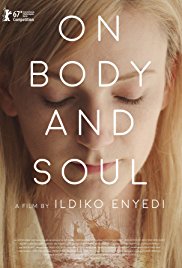
The mood cultivated at certain moments in this Hungarian film, far surpasses the character development and narrative trajectory. This is not the fault of the actors – I think they did a very good job but I think they were severely limited by where the story goes. I am starting to notice this about many highly acclaimed films – they often have exquisitely composed scenes, no detail out of place, everything well thought out, they are masterpieces of mood, and the acting is often exceptional… but it’s at the level of the story and character development (or lack thereof) where things begin to fall apart. Of course, this isn’t always the case but it has been the case, in my experience, a surprising number of times. And, of course, there are many ways in which a story can be told and I’m not particularly invested in classic plot structures (although I am to a certain extent… a lot of prominent stream of consciousness style literature a la Joyce or Faulkner leaves me cold), but there are also a lot of ways in which a story can be poorly told. But perhaps I need to alter my expectations of film. Regardless, I enjoyed several moments of this movie and its portrayal of loneliness, the longing to connect, the difficulty of communicating, and the wonder that accompanies connections when they happen, even though, as a complete package, it kind of falls apart (this is especially the case with the female lead who begins as quite a fascinating character and then devolves into a standard young-conventionally-attractive-but-quirky-woman-in-need-of-rescue-by-a-much-older-more-mature-and-much-less-attractive-looking-man character).
4. Graduation (2016) directed by Cristian Mungiu.
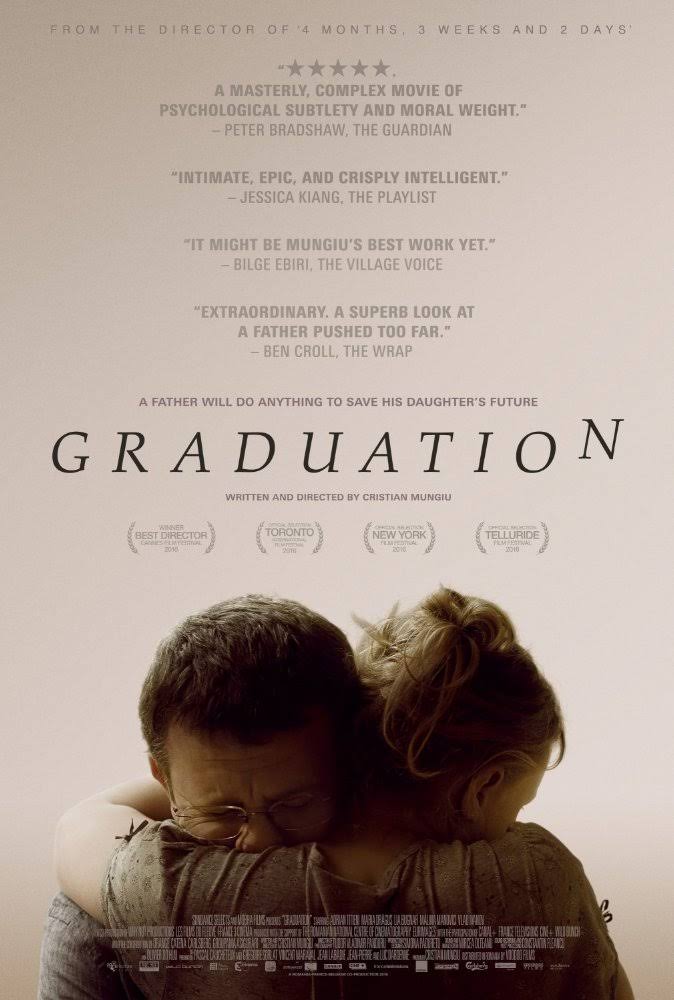
Cristian Mungiu’s Palme D’Or winner as Cannes 2016, is a well told story about men who always think they know best and who always think they are motivated by the best interests of others and who always think they are self-sacrificing but who are, in fact, simply forcing themselves onto others, pushing away those who might otherwise love them, and failing to realize that their vision of liberation is experienced by others as a prison. These are men who think they are always right, and always moral (even when they cheat on their wives or cheat the system, they do so because of “exceptional circumstances” and in the service of a “greater good,” always with the “purest motives,” even if it is only their wealth and gender and privilege that opens these doors to them), and who will never be capable of any kind of self-reflection. They will never become aware that they have no moral basis for their lives apart from their own desires. Hence, when cracks do appear (and cracks run through this whole film – from the broken window at the beginning to the smashed windshield of the car later on) they seem utterly inexplicable to men like these (and who was breaking all that glass?). All of this is wonderfully portrayed in the intimate relationships surrounding a doctor in Romania, his all but dead marriage, his affair with a much younger single mother (and former patient), and, most importantly, his dreams for his daughter who is set to leave shortly for University in England but who is injured while fending off a sexual assault the day before her final exams (the attempted assault is not show). I would say this is recommended viewing, especially for men.
(NB: Mungia also won a Palme D’Or in 2007 for his earlier film, 4 Months, 3 Weeks, and 2 Days about a Romanian college student seeking out an illegal abortion – since abortion is illegal in Romania – but I do not recommend that film. I found it to be incredibly difficult, perhaps even traumatic, not only because of the abortion [I tend to personally struggle a great deal with any representations of abortions in films, notably Mungia’s, Noé’s, and Slaboshpytskiy’s], but because of the sexual exploitation and violence that accompanies it. I feel that Mungiu has matured a lot since 2007.)
5. We Need to Talk About Kevin (2011) directed by Lynne Ramsay.
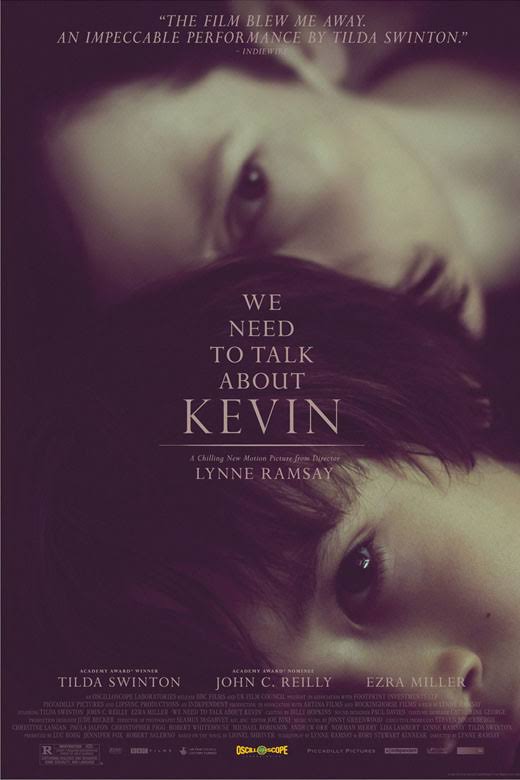
I was looking into films that were generating buzz this year and I noticed a number of interesting reviews of Lynne Ramsay’s latest project, You Were Never Really Here. I wasn’t sure if it was the kind of movie I’d want to watch – and I have since decided that it isn’t (it seems to be derivative of Ben Wheatley’s Kill List, which I fucking hated, although it’s curious to observe that films like these have gained some traction in the UK over the last number of years). However, while I was researching Ramsay, I discovered that she had made a film adaptation of a book about the mother of a child who grows up to become high school shooter. Given recent happenings in Parkdale, Florida (and more generally throughout the USofA this year as at least eight high school shootings have happened since the beginning of 2018), and given the praise this movie received from the critics, I thought I’d check it out. I was sorely disappointed. I felt the movie reinforced harmful ways of thinking about school shootings. Specifically, it presents school shooters as people who are mentally ill from birth – who already seem to be irreparably fucked up from infancy onwards – but, if anyone else is to blame as a contributing factor, it’s probably their moms. In other words, the film contextualizes a school shooter in order to decontextualize the shooting from any factors related to white rage, gun culture, or toxic masculinity. Not only does it do this by blaming women (i.e. stressed out, selfish moms who maybe cause irreparable harm to the mental health of their sons), but it also takes guns out of the equation altogether because the shooter uses a bow. Now, perhaps this was the case because the film didn’t want to come across as exploiting or glamourizing other school shootings, or perhaps this was the case because it didn’t want inspire copycats by showing kids bringing guns to school (and the shooting of other students is not shown although the montage of the shooter at that time struck me as odd and amateurish and not what I expected based on reviews of Ramsay’s earlier works like Morvern Callar and her break-out film, Ratcatcher, which was compared to Ken Loach’s work), but I think one of the things this accomplishes is the vindication of the father of the shooter while villainizing the mother. The father is the one who is presented as patient and loving and interested in playing with his son (even if he is away from home much of the time working), and it is the father who buys the bow for his son (and could he be faulted for never imagining that a bow would be used to kill so many kids at a high school?). The father is portrayed as a pretty one dimensional figure with whom, I think, we are supposed to sympathize and then mourn as a victim. All this would be immediately problematized if the father was shown buying his son a gun, teaching him to shoot, and encouraging him as a shooter (which is more frequently the case in the USofA). But this would immediately bring dynamics into the film – toxic masculinity, gun culture – that Ramsay seems to studiously avoid. Not recommended viewing.
Documentaries
1. Tokyo Idols (2017) directed by Kyoko Miyake.
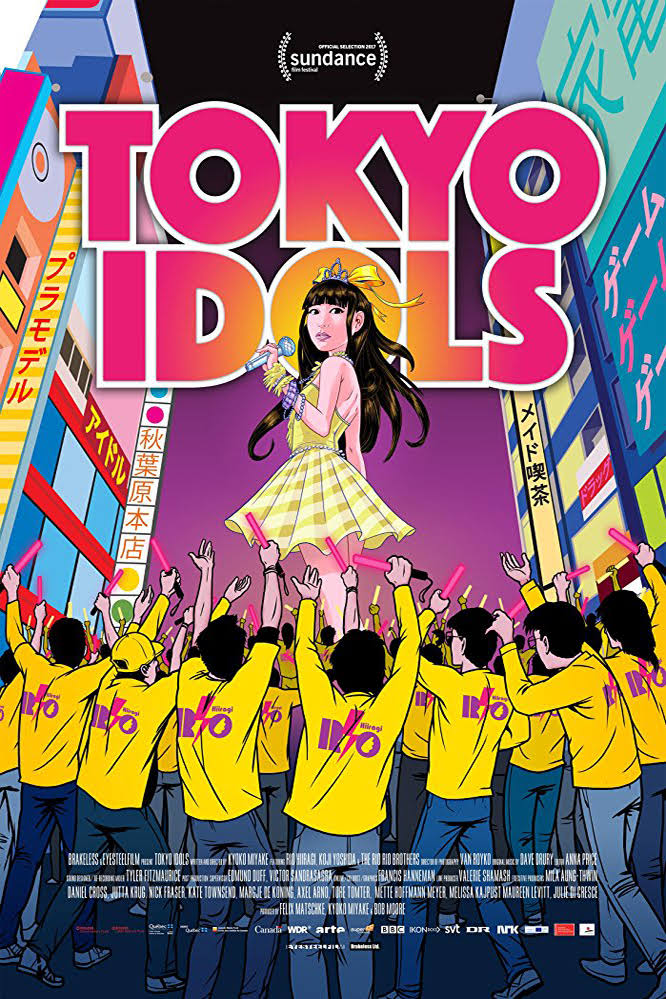
Some years ago, I watched a documentary called The Great Happiness Space, about young, smooth-talking, sharply-dressed, sexually attractive men, who worked as hosts at a club in Osaka attended by wealthy young women who were lured into falling in love and spending more and more money on the men and the club without ever having their love requited (tragically, as the documentary progresses, one learns that these women aren’t actually all that wealthy and also work as hostesses or even sex workers in other clubs). At that time, I was volunteering at a drop-in program for male and trans* sex workers and was interested in the various (but generally neglected by the media or general public) ways in which men engage in sex work or sex-work-like activities (that’s also when I found the documentary Rent a Rasta, about wealthy white women from England, Canada, and the USofA, who go to the Carribbean as sex tourists). I was thinking about The Great Happiness Space again while watching Tokyo Idols, which picks up on another subculture (albeit one that has gone mainstream in some ways and has a very large following), only this time it is men of all ages (although middle-aged men seem especially prominent) who become obsessive fans of teen and sometimes pre-teen girls who perform as “idols” who sing, dance, lip-synch, live-stream, and so on. I was thinking about these two documentaries together because, even though Kyoko Miyake is Japanese and is bringing a feminist critical lens to the topic at hand, it seems to me that white audiences have a strange fascination with Japan when it comes to matters related to sex. Thus, while Miyake hopes to hold a mirror up to patriarchal power dynamics that infect the contexts of viewers in the West (and, it’s true, a Lolita-complex seems to be just as prevalent here as there and I have often heard white men express fantasies about what they would do with submissive Japanese women who have been taught to always obey and, supposedly, take pleasure in doing so), I fear that a significant amount of orientalism and the perception of Japan-as-Other (eroticized Other, fetishized Other, techno-future-robot Other, weird-and-whacky-Other, or some combination of all of these) may interfere with this. That Miyake is a judicious filmmaker who presents us with complex characters – as she seeks to neither villainize nor exculpate the male fans she follows while exploring these dynamics – can also interfere with a reflective reading because, I think, contemporary audiences generally have a very simplistic understanding of sex and what kind of sex is good (i.e. not illegal) or bad (i.e. totally illegal, since morality tends to be conflated with the Law and how much one can get away with under the Law) and what kinds of people tend to be good or bad in equally black-and-white ways (hence, this whole conversation about “Cat Person”).
However, this lack of general understanding is not Miyake’s fault and perhaps her presentation will contribute to overturning it. Because the men are complicated. On the one hand, they are seemingly gentle and respectful, on the other hand they are clearly sexually or romantically attracted to the girls, and on the third hand (is that a thing?), they also express and try to enact father-daughter dynamics in their relationships with the girls. Now, granted, freely consenting adults can decide they want to engage in parenting-type roles in their sexual or romantic relationships (maybe a woman wants to call her lover daddy, maybe a man wants his lover to mother him) but that’s one thing if it takes place between freely consenting adults, and another thing altogether when those things get blurred together in relationships between adults and children. That, of course, is the obvious creep factor to this whole thing but, in my opinion, what is very, very troubling (and what reveals this to be a deeply rooted systemic issue) is that all the men who engage in this kind of fantasy in the film are genuinely gentle, kind, and pretty much entirely normal people. That people who clearly value things like kindness and respect can indulge in these things without so much as batting an eye, means we’ve got an issue with deep roots. Miyake does a good job of showing this, but Western audiences titillated by another examination of a Japanese sub-culture that has sexual overtones, might have to stop and think awhile to reach that conclusion. Given that Western audiences aren’t inclined to stop and think, I’m a little worried we won’t ever get there.